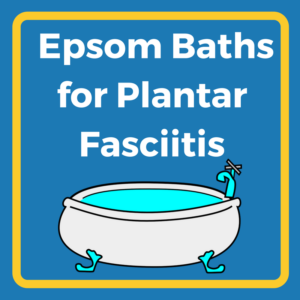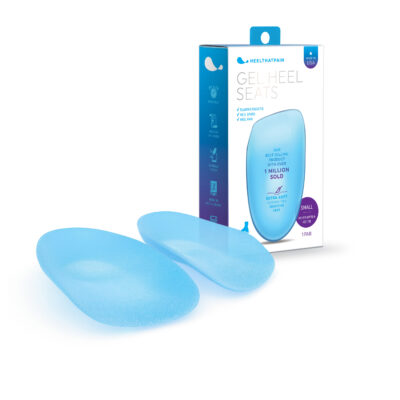 Epsom salt soaks are one of oldest go-to home remedies for a wide array pains and inflammation.
Epsom salt soaks are one of oldest go-to home remedies for a wide array pains and inflammation.
But does science back up the impressive claims of their effectiveness? Are epsom salts really a miracle cure? What about epsom salts and essential oils?
While epsom salts come highly recommended as a home treatment for plantar fasciitis, evidence suggests you’ll want to take these claims with a grain of, well, salt!
In this post we’ll explore how epsom salts work, the evidence for their effectiveness in treating plantar fasciitis and heel pain, and other at-home remedies to try:
Do Epsom Salts Really Work?
The short answer to “Do epsom salts really work?” is yes! The active ingredient in epsom salts, magnesium sulphate, has been approved for use as a laxative by the FDA. Studies have also shown magnesium sulphate’s usefulness in treating heart arrhythmia, tetanus, and eclampsia.
Unfortunately, the evidence for epsom salts’ effectiveness at treating pain–including plantar fasciitis and heel pain–is more meager. While there’s no conclusive evidence that epsom salt baths or foot soaks are detrimental to plantar fasciitis, there’s also no real body of evidence that epsom salt baths are significantly more effective that a regular bath or soak.
While one 2009 study and several 2007 studies showed some effectiveness of magnesium in reducing pain, a greater number of studies contradict this finding, showing no difference in pain reduction.
Does this mean you should give up on a soak with epsom salts if you suffer from heel pain? Not so fast.

Benefits of Epsom Foot Soaks for Heel Pain
While it’s true that claims about the effectiveness of magnesium sulphate in epsom salts don’t have much basis in peer-reviewed studies, there’s no reason to discount the large body of anecdotal evidence for epsom salts and soaking your feet in general.
Taking a long, hot soak in the bath gives your feet time to rest and rejuvenate (something almost all podiatrists and doctors recognize as one of the most important parts of recovery!). A soak in the bath–especially with epsom salts, which can soften the skin–can also have tremendous benefits to your mental health, relaxing your body and reducing levels of cortisol (the stress hormone), which can be a major player in inflammation.
If you’re interested in trying epsom salts, there’s very little reason why you shouldn’t. At worst, you’ll enjoy a warm, relaxing bath and softer skin. At best, you may find that your heel pain does, in fact, improve. After all, an entire box of epsom salts, found in the pharmacy section of your local grocery store, will cost you somewhere in the neighborhood of $2!
Most websites and individuals who recommend the use of epsom salts recommend adding two or three tablespoons of epsom salts to a shallow bath meant for a foot soak alone. The water should be hot, but not uncomfortable, and feet can be soaked twice a day for about fifteen minutes. If you prefer a whole-body soak, add approximately one cup of epsom salts to an entire bathful of water.
Epsom Salts and Essential Oils

Epsom salt baths and essential oils are a popular combination. And while, like epsom salts, the scientific evidence for the effectiveness of essential oils in treating plantar fasciitis is meager, there are still many potential benefits to using essential oils in combination with epsom salt baths, especially if you find a particular scent soothing or pleasant.
A relaxing soak with epsom salts, followed by a self-massage session with essential oils can calm the mind and body, as well as improving blood flow to the feet and heels. The pleasant smell and feel of essential oils can provide extra incentive to massage the feet regularly, one of the most important aspects to healing!
Other Home Remedies to Try
In addition to (or in lieu of) soaking with epsom salts, try the following proven home remedies to reduce heel pain and treat the underlying cause of plantar fasciitis. It’s also worth noting that while home remedies like epsom salt baths and essential oils may indeed improve symptoms, the true healing of plantar fasciitis begins with treatments that address the damage and inflammation to the plantar fascia and surrounding muscles and ligaments.
Treatments for plantar fasciitis like these stretches and simple exercises can have a big impact in the amount of pain you feel on a daily basis (especially in the morning!). While these stretches may seem simple, they can be incredibly effective in improving blood flow, strengthening the plantar fascia and surrounding tissues, and increasing flexibility. Many people also find success with icing their feet regularly to reduce inflammation and pain.
Affordable, specialized orthotic inserts are one of the most effective at-home treatments for plantar fasciitis. These inserts can be added to almost any pair of shoes and stimulate your body’s natural healing abilities by targeting pressure points and raising your arch to the optimal level.
The good news is that because treatments like epsom salts, essential oils, orthotic inserts, and stretching are both affordable and low-risk, you should try any combination of these treatments to find what works best for your pain and lifestyle.




thank you for any help you can recommend for my heel pain
Well I have bone spurs and plantar fasciaitis. I’ve been in pain for two years, the pain is so bad I can barely walk. I just tried a foot soak consisting of two cups of Epsom salt with a couple quarts of hot water. I soaked them 25 mins, I’m walking and feel no pain at all for the first time in two years , So I’m gonna say there is scientific proof that soaking your pain riddin feet in Epsom salt really works ! If I have to soak them in this solution several times a day, I’m gonna because I can’t live in this pain any longer and I’m willing to try anything to heal it.
Tracy, did you do anything else like stretching & icing? My husband did stretching, icing & good inserts religiously but it has not helped! I recommended the salt baths and told him about your results and he wanted to know if you did other things. I hope this works and he for him
I have tried just about everything possible. I have Planterfacitis in both feet and 3 pinched nerves in left foot and 2 in right. Tried inserts bought at Dr office, PT, shots, exercises, water bottle. Getting ready as last result to have the surgery. Ibha be had it now for over 3 years and it’s effecting my daily life.
I have a heel spur and I’m soaking my foot in hot water with epsom salt will that work?
yes, it definitely does. I have been suffering from heel spur for almost 18 months but epsom salt and lavender oil combination with hot water has almost cured my heel spur.
I have plantar fasciiatis for more than a month now. When I stop stretching, soaking in Epson salts (ess. oils) and massaging: it comes back. So from now on, I will soak twice a week. My left heel is very painful. I avoid walking barefoot, I wear crocs.
Am going to try the Epsom salt on my heel fasciiatis today hope to here result from me
Epsom salt soak 30 min twice daily until the plantar fasciitis is gone. Do the soak twice a week once you’ve fixed your foot. Once or twice does not do it. It has to be a lifestyle. Also massaging the bubbles from the hurt heel is very effective all g with the soaks. Cheers
I have requested the eBook 3 or 4 times, but have yet to receive it.
So just how do you get it?
How much epsom salt do I put in my water?
Or does it matter?
I tore my fascia. Will this help heal it?
I also ruptured my planta fascia 10mm back in December last year and have spent a small fortune on profesionals and shoes and still in alot of pain. Im in the process of having Orthotics made. Any advice would be much appreciated.
When I had plantar fasciitis, I wore a walking boot for 3-4 months. It cured it.
You used epsom salt on your plantar fasciitis how it cured. Two time a week on soaked with warm on the small tub with the epsom salt?
I wonder if the warm water relaxes the muscle so the heel pain isn’t so bad. The pain is worse once you’ve been off your feet until you get moving and warm up the muscle. Regardless, soaking my feet in a warm Epson salt bath seems to help the pain. I’ve had pain for over 5 months and a cortisone shot that only helped for a week.
I have just returned to work after 8 years off, the pain is unbelievable!
My feet knees hips and back, nearly makes me cry after 2 1/2 hours. I have tried four different kinds of shoes, one expensive pair of orthotics , several pair of inserts, to no avail!!
Right now I am soaking my feet in, hot water with epson salt , Vick’s salve, and apple cider vinegar. I will let you know how that works!
I had extremely painful pf for months back in 2014 so I did research on walking barefoot. It turns out that because we shod our feet all the time and are not using the proper muscles that we would if we walked barefoot. the muscles in our feet can begin to atrophy. So I went barefoot for 5 months (I lived on an egalitarian community and so could do this) at first I carried flip flops because the pain was so intense, but after a few weeks the pf went away and I didn’t have any problems from that time forward, until recently. I no longer live on this farm and hardly ever get to go barefoot 🙁 my left heel hurts so badly…I’m soaking my feet now and will begin walking around in yard barefoot….again. Also connecting to the earth is highly beneficial. Look it up!